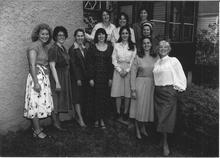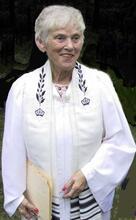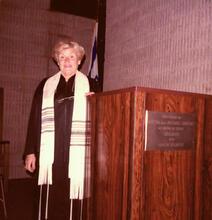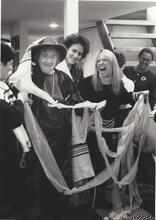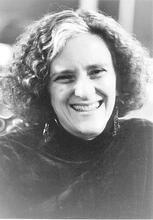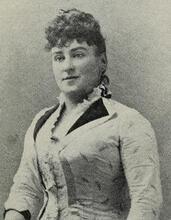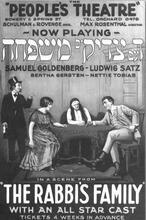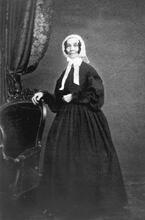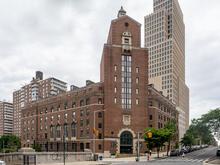Cantors: American Jewish Women
Women’s vocal leadership in synagogue practice began when educated women served as zogerin (women’s prayer leader). In America, the idea of Jewish women singing religious songs became refracted into dramatic productions on the Yiddish stage. Starting in the nineteenth century, women participated in mixed choral and community singing, and some opera singers were called upon to act as cantors in important Reform congregations. Subsequently, new technologies allowed women “khazntes” to produce recordings or sing hazzanut (cantorial singing) on the radio. Although not considered professional cantors, some women began to lead worship services in synagogues. The Reform (1975) and Conservative (1987) movements began formally investing women as cantors, opening the floodgates of participation. Today a plurality of cantors in liberal movements are women.
Historical Antecedents
The vocal leadership of Jewish women in synagogue practice dates back at least to the twelfth century, when gendered worship spaces began in European synagogues. For the most part, the women serving as zogerin (female prayer leader, also called firzogerin, zogerke, or sagerin) were those educated enough to lead the women’s sections during prayer, reciting the liturgy so it could be more easily heard by women in the synagogue section or gallery. Local accounts alternately describe these recitations as using a sing-song voice or a stylized weeping or ritualized speech pattern to create emotional reactions. Other accounts describe the singing as sweet and adding beauty to the prayers. The gravestone of one thirteenth-century woman, Urania of Worms (d.1275), states that she “‘chanted piyyutim (liturgical poems) and supplications for the women’ —to have acted, in fact, as a female cantor” (Cohen, 1906). Other graves and writings name individuals, such as Richenza of Nuremberg (d. 1298) or Dulcea of Worms (d. 1196), while most of these women remain anonymous.
While the role of zogerin was widely known and discussed in scholarly literature, it was most often distinguished from the advanced musical styles of hazzanut (cantorial singing) used by men. Among the traditional reasons for excluding women as prayer leader or sh’liach tzibbur (messenger of the people) was the concept of “kol isha” (the voice of a woman). This term is used to express the Jewish prohibition of women leading prayer, as women’s voices were seen as a distraction to men due to their sexual attraction or ervah, (“nakedness”). Nevertheless, in the women’s sections and even in a special prayer house known as a weibershul (women’s synagogue), the role was still widely practiced. By the late nineteenth and early twentieth centuries, the role declined, whether due to the lack of need, the advent of mixed Reform seating, migration to America, or the increasing professionalization of the cantorate. Nevertheless, the ancient role of zogerin was brought to the United States. Nineteenth-century Jewish newspaper accounts describe a “Chazanta” in the South Bronx in New York in 1896. The Jewish Encyclopedia of 1906 noted that the custom was still followed in Eastern European congregations.
Jewish women leading liturgical prayer and spiritual songs were also represented in dramatic productions on the American Yiddish stage. Nineteenth-century American Jewish audiences were not shocked by this presence because they were already familiar with the role of zogerin, as well as accustomed to hearing Jewish women singing outside the synagogue in community events, such as the dedication of a synagogue or in large American music festivals. Nevertheless, as the Yiddish American theater developed, these musical roles rose to new heights by having extraordinary singers perform solo roles of religious hymns and liturgical chants and by creating new music of spiritual significance. For example, in the production Brokhoh, Sophie Karp (née Sara Segal, 1861–1906) introduced a Yiddish ballad written especially for her by Peretz Sandler, entitled Eli, Eli (My God, My God), with text material derived from Psalm 22 and other Jewish prayers. The song became a favorite solo of many other female performers of that day, including renowned actor Bertha Kalich (1874-1939) and opera singers Sophie Braslau (1892-1935) and Rosa-Raisa (1893-1963). In 1918, the popular singer-actor Regina Prager (1886-1949) starred in a successful musical production called Di Khazinte (The Lady Cantor).
In the first decades of the twentieth century, new mechanical production came about with the rise of recordings and radio, allowing both the preservation and wide dissemination of female voices. Jewish women singers turned their talents toward liturgical music in many performance venues and were often recorded and heard on radio. These women came to be called the “Khazantes,” or women who straightforwardly sang cantorial music outside of the synagogue. Most either came from cantorial families or were otherwise steeped in Jewish culture and hazzanut. While not allowed to lead services in synagogues due to kol isha restrictions, they nevertheless used their impressive vocal talents and progressive attitudes to sing liturgical music, often donning cantorial robes, and some even wore the cantorial mitre in concerts. They usually sang in the lower vocal registers, in the chest, imitating the then-prevailing styles of male cantors. Among the most famous of these women (many of whose recordings still exist) were Lady Cantor Madam Sophie Kurtzer (1896-1974), Bernice Kanefsky Hausman (known as Bas Sheva, 1925-1960), Jean Gornish (known as Shaindele di Khaznte, 1915-1981), Perele Feig (known as the Hungarian Khaznte, 1910-1987), Goldie Malavsky (1923-1995), and Fraydele Oysher (1913-2003). Each of these women contributed in numerous and significant ways to the changing aesthetics and perceptions in the Jewish community of women singing sacred Jewish music.
Traditional (Male) Cantorial Training
During the nineteenth century, there was no formal system of training for cantors in America. Those who became cantors learned through an apprenticeship system. They studied with a mentor or from a senior synagogue cantor. Not until the twentieth century, following World War II, did the American Jewish community began to establish institutions of Jewish learning for cantors. These schools were all originally exclusively for men. Among those were the School of Sacred Music at the Hebrew Union College–Jewish Institute of Religion (now the Debbie Friedman School of Sacred Music, DFSSM at HUC-JIR, founded1948), the Cantors Institute and College of Liturgical Music of the Jewish Theological Seminary of America (now the H. L. Miller Cantorial School and College of Jewish Music, founded 1952), and the Cantorial Training Institute at Yeshiva University (now the Philip and Sarah Belz School of Jewish Music, founded 1964). Along with these three schools for cantorial studies, three professional denominational cantorial associations were also formed: the Reform-based American Conference of Certified Cantors (now the American Conference of Cantors, ACC, 1952); the Conservative-based Cantors Assembly of America (CA, 1947); and the Orthodox-based Cantorial Council of America (CCA, 1960). Additionally, the Jewish Ministers Cantors Association of America and Canada (also known as the Chazzanim Farband), founded in 1897, continued to serve as a type of cantor’s union and support organization.
Women Serving as Cantors
In the American synagogue itself, changes challenging male exclusivity began as early as the nineteenth century. An internationally famous opera singer, Julie Eichberg Rosewald (1847-1906), was called upon to lead services at the Reform Temple Emanu-El in San Francisco. While not the first female soloist at a Reform synagogue, she was the first woman known to have an official cantorial role, serving from 1884 to 1893 as “Cantor Soprano” at Emanu-El. In that capacity, Rosewald fulfilled many of the modern roles of a cantor: she sang the solo parts normally reserved for a cantor, chose the music and brought in new selections, directed the choir, collaborated with the organist, and directed the music of the synagogue.
While Rosewald’s function is often seen as unique, a comparable role was filled just a few years later by Josephine Jacoby (1875-1948). A contralto born in Brooklyn and trained in New York, she was a vocal soloist for Temple Emanu-El in New York at major events, such as the funeral of Isaac Mayer Wise in 1900. A singer at the Metropolitan Opera, Jacoby was called upon as a soloist and choral singer not only to sing in religious services but also to represent Temple Emanu-El at numerous interfaith concerts and other special occasions, another important aspect of the growing role of the cantor in America.
Increasingly, other gifted female musicians were participating in the religious musical expression of American Jewry. As early as the mid-nineteenth century, women had joined as formal choristers in congregations around the country. Despite heated discussion in the press, restrictions on women’s vocal participation were gradually lifted through the efforts of champions for mixed choirs, such as Isaac Mayer Wise in Cincinnati. By the 1930s, except at Orthodox synagogues, women sat with men and intoned the prayers in congregational unity. Increasingly, women were featured singers in religious choirs, and synagogue singing was becoming a shared domain with men.
In 1955, Betty Robbins (née Bertha Abramson, 1924-2004) was appointed as cantor of Temple Avodah, a Reform congregation in Oceanside, New York. Born in Greece, as a child she lived in Poland, where she persuaded the cantor of her local synagogue to allow her to join the congregational boys’ choir. Her family escaped Poland to Australia, and from there she came to the United States. Her appointment as a cantor ranked as a front-page item in the New York Times on August 3, 1955. Over the next several decades, as women’s roles in society changed, additional women took on similar roles to Robbins. Other women educated in liturgical song but not officially ordained were hired as cantors. The practice of hiring women singers to lead services spread to many communities, including those outside of metropolitan areas, such as Donna Goldfarb (1946-2024), who began serving as a cantor at Temple Beth Jacob in Concord, NH, in 1975. Others were in more heavily Jewish metropolitan areas, such as Julie JoHanna Engel (1922-1980), who served at Temple Judea in Howard Beach, NY, from 1976 to 1978.
Official Recognition

First Women Cantors’ Network Conference, Congregation Beth El
Norwalk, CT, May 1982. Left to Right: First row: Deborah Katchko (Norwalk, CT), Linda Shivers (Highland Park, NJ), Doris Cohen (Flushing, NY), Rochelle Helzner (Washington, D.C.), Jane Myers (Philadelphia, PA), Elaine Shapiro (W.Palm Beach, FL), Ruth Devorah (New York, NY). Second row: Sue Roemer (Silver Spring, MD.), Tzippy Bronstein, (Brooklyn, NY), Sheyne Mueller (New York, NY). Third row: Rita Glassman (New York, NY). Courtesy of the Women Cantors’ Network.
“Voice of Miriam”: First All-Female Cantorial Concert, Great Neck, NY, 1980.
Reform Movement
Until the 1970s, women who studied liturgical music at the School of Sacred Music at HUC–JIR (Hebrew Union College-Jewish Institute of Religion) were preparing to serve congregations as music teachers and choral leaders. Following its first ordination of a female rabbi, Sally Priesand (b. 1946), in 1972, the Reform Movement began to consider female music students for cantorial studies and formal ordination.
In 1975, Barbara Ostfeld (b. 1952) became the first woman to be ordained as a cantor at HUC-JIR. She received immediate pulpit placement following ordination and was inducted into the American Conference of Cantors (ACC). Early in life, Ostfeld had become interested in Jewish music, and as a child she was active in Reform temple activities in Oak Park, IL, and admired the teachings and social activism of her rabbi and cantor. After high school, Ostfeld enrolled at Hebrew Union College in New York, where her studies included traditional hazzanut as well as Reform liturgy and music. Ostfeld served in various student pulpits, and after ordination she served congregations in Great Neck, Rochester, and Buffalo, NY. From 2002 to 2012, she served as the Placement Director of the American Conference of Cantors. In 2019, she published her memoir, Catbird: The Ballad of Barbi Prim, which describes her early life experiences.
Within five years of Ostfeld’s ordination, enough women were involved in the movement that on April 27, 1980, the first all-female cantor’s concert called “The Voice of Miriam” was held at Temple Beth El in Great Neck, NY. Participants included Cantors Phyllis Cole, Mimi Frishman, Nancy Hausman, Barbara Ostfeld, and Sarah Sager, and student cantors Gail Hirschenfang, Dana Smookler (now Anesi) and Jodi Sufrin.
Cantor/Rabbi Vicki Axe (b. 1948) was the first woman to serve as President of the ACC, from 1991 to 1995. She was followed by Cantor Judith K. Rowland (b. 1956) from 1995 to 1998 and again in 2000-2001, Kay Greenwald (2007-2010), and Susan Caro (2010-2013), raising female leadership to a new level of significance.
Conservative Movement
While not officially ordained, Linda Rich (b. 1952), who grew up in an Orthodox family, served as the first female cantor in a Conservative pulpit at Temple Beth Zion in Los Angeles starting in 1978. A fifth-generation cantor, Rich initially learned by assisting her father singing and conducting their choir growing up. Rich has a remarkable vocal range but often sings in the lower tenor-alto range, which she found was easier for her congregation to accept. Her daughter Rachel (b. 1990) was hired as a cantor by Temple Rodeph Shalom in Redondo Beach, CA, making six consecutive generations of cantors in the family. In 1996, Linda Rich was awarded the Diploma of Hazzan Minister from the Jewish Theological Seminary (JTS) and accepted into the Conservative movement’s Cantors Assembly, almost two decades after working in her first pulpit.
Although Elaine Shapiro (b. 1952) was educated at JTS and was the first woman with a degree in Sacred Music from JTS’s College of Music, ordination was not yet available from JTS at the time she completed her studies. Nevertheless, in 1979, she was invited to serve as cantor at Temple Beth-El in West Palm Beach, and later at the Reform Temple Sinai in Delray Beach, where she became a full-time cantor.
Doris Siegel Cohen (b. 1933), a former liturgical soloist often called a “khazante” in her youth, worked with composer and conductor Sholom Secunda (1894-1974), sang with Moshe Ganchoff (1904-1997) by age twelve, and sang on radio station WEVD on the Forward Hour. From the age of fifteen, Cohen sang on holidays as a featured soloist at the Concord resort with illustrious cantors such as Richard Tucker (1913-1975). After serving as a music director in Lynbrook, NY, she served Temple Israel of Canarsie for twenty-eight years as cantor. Cohen served as second president of the Women Cantors’ Network from 1988 to 1994.
Deborah Katchko (b. 1957), who came from a cantorial family, was convinced by studies with Elie Weisel at Boston University to continue in her family’s tradition. Granddaughter of eminent European cantor Adolph Katchko (1886-1958), whose compositions were the backbone of cantorial education, she trained privately with her father, Cantor Theodore Katchko (1927-1997). Beginning in 1981, she served Congregation Beth El in Norwalk, CT. Feeling the need for more support for female cantors, she founded the Women Cantors’ Network in 1982 with a small group of women, including Elaine Shapiro and Doris Siegel Cohen. Katchko served as President of the organization from 1982 to 1988. She was the first recipient of the Debbie Friedman Miriam Award given at the Miriam’s Table Annual Women’s Seder event in April 2020.
While women had been attending classes at JTS’s College of Jewish Music since the late 1950s and some had earned formal degrees in sacred music, it was not until 1983 that two students, Erica Lippitz (b. 1956) and Marla Rosenfeld Barugel (b. 1956) applied and were permitted to prepare for ordination. Within the Conservative movement, there was some strong opposition to this change, based on traditional interpretations of the prohibition of “kol isha.” Nevertheless, many established cantors championed the cause of women’s investiture, including Sam Rosenbaum (1919-1997), Max Wohlberg (1907-1996), Pinchas Spiro (1922-2008), Jacob Mendelsohn (b. 1947), and Nathan Lam (b. 1947). Consequently, based on a ruling in their fourth and final year by Chancellor Ismar Schorsch (b. 1935), the two women were ordained in 1987 and both were placed at congregations. Subsequently, over one hundred other women completed and received cantorial ordination. Many in the Conservative movement welcomed the addition of women, as there was a national shortage of Conservative cantors at the time. While initially strong reservations persisted among many Conservative cantors concerning acceptance of women in pulpits, the Cantors Assembly of America, the Conservative professional organization, formally admitted female cantorial graduates in 1990. Admission into the CAA led not only to more professional recognition but also to additional opportunities and an increase in salaries and job benefits. The first woman to serve as president of the Cantors Assembly was Nancy Abramson, from 2013 to 2015, followed by Alisa Pomerantz-Boro, from 2017 to 2019.
Reconstructing Judaism and Renewal Movements
In 2002, Sharon Hordes (b. 1974), who trained at Gratz College and the Reconstructionist Rabbinical College in Wynecote, PA, became the first woman ordained as a cantor in the Reconstructionist movement (now called Reconstructing Judaism). Those wishing to serve as Reconstructionist cantors continue to study at partnering institutions, as the movement has no specialized cantorial school.
The Jewish Renewal movement ordains cantors through its Alliance for Jewish Renewal (ALEPH) program. Its most famous woman musician is Shefa Gold (b. 1954), ordained both as a Renewal and Reconstructionist rabbi; Gold combines Jewish liturgical texts and music with chants based on Buddhist, Sufi, and Native American practice rather than Jewish musical traditions. Her newly created Jewish chanting has spread significantly throughout the United States and has impacted synagogue practices in other movements. She leads formal training programs in chant leading. She has produced numerous musical recordings, written new liturgical texts, and written several books, including The Magic of Hebrew Chant: Healing the Spirit, Transforming the Mind, Deepening Love (2013).
Orthodox Movement
Following a more traditional route, Orthodox women may serve as a sh’liach tzibbur in some women’s The quorum, traditionally of ten adult males over the age of thirteen, required for public synagogue service and several other religious ceremonies.minyanim, but to date, no women have been admitted to the Orthodox cantorial training at Yeshiva University. However, many Orthodox women sing religiously inspired pieces outside the synagogue in all-women venues. In Descendants of the Jews who lived in Spain and Portugal before the explusion of 1492; primarily Jews of N. Africa, Italy, the Middle East and the Balkans.Sephardi communities, para-liturgical music by women has continued to play a major role in everyday life.
Supporting Organizations
The Women Cantors’ Network organization, now with a membership of over 300, provides support, continuing education opportunities, and a forum for discussion of practical issues pertaining to women in the cantorate. In addition to WCN’s annual study conferences, the organization has produced a regular newsletter since 1983 and began commissioning new musical composition in 1997. In 2019, WCN published a songbook of members’ compositions called Kol Isha: Songs and Settings of Prayers.
Along with cantorial associations, affiliated organizations support women in synagogue music. Founded in 1896 as both an educational and a service organization, the American Guild of Organists has a mixed constituency of liturgical musicians, men and women, Jews and non-Jews. In 1987, the ACC established the Guild of Temple Musicians, which represented accompanists, conductors, composers, music directors and soloists.
Impact of Women Cantors on American Jewish Music
Women cantors have been part of an expanding role for cantors in America, as cantor-educators, in pastoral care, and as cantor-composers and singer-songwriters. Having attended Brandeis University and the New England Conservatory simultaneously, Sheila Cline (1941-2020) became the second woman ordained as a cantor at HUC-JIR in 1976. After years as a pulpit cantor, she took her career toward a pastoral role, becoming certified in Jewish education, gerontology, and pastoral counseling. She served many institutions as a chaplain, and her expertise expanded into community relations.
Among the most prominent of the cantor-composers is Benjie Ellen Schiller (b. 1958), who became the first full-time faculty member of the Debbie Friedman School of Sacred Music at HUC-JIR in New York in 1987, where she holds a named professorship of Liturgy, Worship and Ritual as well as serving as a professor of Cantorial Arts. Other cantors, such as Faith Steinsnyder (b. 1957), serve as role models to their fellow women cantors. Steinsnyder is the first woman to teach traditional hazzanut and cantorial repertoire at HUC-JIR, JTS, and the Academy for Jewish Religion. She is known widely for concertizing the classics of hazzanut. Deborah Katchko-Gray produced the first publication in which traditional hazzanut was made available in female-friendly vocal ranges with guitar chords.
The presence of cantors who are also singer-songwriters has increased exponentially in recent years. Along with changes in musical vocal range and timbre, women cantors have created new music celebrating life cycle events and written new liturgical texts important to women. Linda Hirshhorn (b. 1947), a singer-songwriter who sang as a teen in Zamir Chorale in New York and became leader of the ensemble Vocolot, was officially invested as a cantor and served congregations in California. Cantor/Rabbi Rachelle Nelson (b. 1956) is well known throughout the United States as a composer of Jewish music, as is Cantor Natalie Young (b. 1974), whose music can be found in numerous publications and has been performed widely at Jewish music festivals and conferences. Many, such as Rosalie Boxt (b. 1973), current Director of Worship at the URJ, marry contemporary Jewish music with community singing. Boxt is known for encouraging new compositions of Jewish worship music. In liberal movements, cantors today commonly combine song leading in worship with guitars, drums, and other instruments. Cantor Lisa Levine (b. 1960) combines cantorial arts with composition, drumming, and meditation practices. Many women cantors sing new Jewish music that blends with other American styles and genres; Beth Styles, for example, uses gospel, pop, and Jewish song blended in creative ways.
Today, there are more female cantors than male in liberal North American congregations. Some have served in some of the largest congregations in the country, such as Cantor Lori Corrsin (b. 1954), at Congregation Emanu-El in New York, and Cantor Roslyn Barak (b. 1950), who served at Temple Emanu-El in San Francisco until her retirement in 2015. In reflecting upon her chosen profession, Barbara Ostfeld, the first woman ordained as a cantor in the United States wrote, “Women cantors have altered the way in which prayer is offered, heard, and received.”
Adelstein, Rachel. “Braided Voices: Women Cantors in Non-Orthodox Judaism.” PhD diss., University of Chicago, 2013.
American Conference of Cantors. “ACC Spotlight: Cantor Rosalie Boxt: Cantor Rosalie Boxt is Director of Worship at the URJ.” American Conference of Cantors. https://www.accantors.org/cantor-spotlight/acc-spotlight-cantor-rosalie-boxt.
American Conference of Cantors. “Remembering Sheila Cline.” Accessed January 13, 2021.
Andres, Holly. “Conservative Female Cantor Fits In.” The Los Angeles Daily News, March 1, 2008.
Axe, Vicki. “Vicki Axe. Interview by Marcie Frishman.” Digital Collections, Wesleyan University, 1986.
Axe, Vicki “Oral Interviews.” Columbus Jewish Historical Society. October 23, 1996.
Baranblat, Rachel. “In Song Together: For Linda Hirschhorn, Music is a Path to Transformation.” Zeek, January 24, 2012. https://zeek.forward.com/articles/117414/
Barak, Roslyn. Personal Interview with Judith Pinnolis, November 2, 2020.
Barak, Roslyn Jhunever. "Roslyn Jhunever Barak: Song and Spirit: A Cantor’s Life Congregation Emanu-El, San Francisco, 1987-2015." Interview by Basya Petnick. 2014 and 2015. Oral History Center, The Bancroft Library, University of California, Berkeley, 2017.
Barugel, Marla Rosenfeld. “Breaking Past Barriers and Looking Ahead.” Journal of Synagogue Music 32 (2007): 36-37.
Berman, Saul. “Kol ‘isha,” in Rabbi Joseph H. Lookstein Memorial Volume, ed. Leo Landman (New York: Ktav Publishing House Inc., 1980):45-66.
Biddle, Marc. “Sour Notes Remain for Women as Cantors.” The Chicago Tribune, March 13, 1987.
Brown, Adrianne. “The Khazntes—The Life Stories of Sophie Kurtzer, Bas Sheva, Sheindele the Khaznte, Perele Feig,Goldie Malavsky, and Fraydele Oysher.” Journal of Synagogue Music 31 (2007): 51-79.
Brzozowski, Carol. “Women Cantors Find Acceptance in Male-Dominated Vocation.” The South Florida Sun-Sentinel. November 21, 1986.
Cantorial Council of America. “Cantorial Council of America,” Belz School of Jewish Music, Yeshiva University. Accessed January 13, 2021.
Cantors Assembly. “History of the CA.” Cantors Assembly. Accessed January 13, 2021.
Chandler, Russell. “Jewish Temple Names Woman Cantor.” The Los Angeles Times. July 2, 1978: C2.
Cohen, Doris. Interview by Shayna Mueller. Digital Collections, Wesleyan University. May 13,1986.
Cohen, Francis L. “Sagerin.” The Jewish Encyclopedia. 1906. Accessed January 13, 2021. http://www.jewishencyclopedia.com/articles/12991-sagerin
Cohen, Judah M. “Professionalizing the Cantorate—and Masculinizing It? The Female Prayer Leader and Her Erasure from Jewish Musical Tradition.” The Musical Quarterly 101, no. 4, (Winter 2018): 455–481.
Cook, Joan. “A Female Cantor? Two Women Who are Bucking Tradition.” The New York Times. February 22, 1971: 20.
Dart John. “Seminary Decision Opens Door for Women Cantors.” The Los Angeles Times. February 14, 1987: A5.
“Editorial Notes,” The American Hebrew. October 9, 1896: 569.
Fishman, Bob. “Rabbi Vicki Axe to step down at Shir Ami in Greenwich.” The Connecticut Jewish Ledger Online, August 15, 2018.
Goldfarb, Donna. Personal Correspondence with Judith Pinnolis. April 9, 2021.
Goldman Karla. Beyond the Synagogue Gallery: Finding a Place for Women in American Judaism. Cambridge, MA: Harvard University Press, 2000.
Graham, Nancy. “Woman Cantor Surprises Olympians.” The Los Angeles Times, August 2, 1984: A1.
Harris, Ben. “With Shruti Boxes and Drums, Practitioners Chanting Their Way into Judaism,” Jewish Telegraphic Agency, November 23, 2010.
Katchko-Gray, Deborah. Personal Interview with Judith Pinnolis. June 17, 2020.
Klepper, Jeff. “The Voice of Women” Concert Program. Temple Beth El in Great Neck, New York, April 27, 1980. In Private Collection of Jeff Klepper.
Levine, Joseph A. “The Issue of Women Cantors: Landmarks Along the Way.” Journal of Synagogue Music 32 (2007): 5-14.
“Memorial Services for Rabbi Isaac M. Wise.” The New York Times, April 30, 1900: 12.
Ostfeld, Barbara. “The Ascent of the Woman Cantor: Shira Hamaalot.” In New Jewish Feminism: Probing the Past, Forging the Future, ed. by Rabbi Elyse Goldstein, 133-143. Woodstock, VT: Jewish Lights Publishing, 2009.
Ostfeld, Barbara J. Catbird: The Ballad of Barbi Prim. Buffalo, NY: Erva Press, 2019.
Pinnolis, Judith S. “Benjie Ellen Schiller,” The Jewish Music WebCenter. March 2000.
Pinnolis, Judith S. “‘Cantor Soprano’ Julie Rosewald: The Musical Career of a Jewish American ‘New Woman.’” The American Jewish Archives Journal 72 no.2 (2010): 1-53.
Pinnolis, Judith S. "Ostfeld, Barbara Jean." In Encyclopaedia Judaica, 2nd ed., edited by Michael Berenbaum and Fred Skolnik, 507. Vol. 15. Detroit, MI: Macmillan Reference USA, 2007.
Ramos-González, A. “Daughters of Tradition: Women in Yiddish Culture in the 16th-18th Centuries.” European Journal of Women's Studies 12 no.2 (2005): 213-226.
Rivera, John. “Cantor says gender is no longer an issue Clergy: Judith K. Rowland, whose father was a Reform rabbi, decided in college to attend cantorial school. A woman leading worship in Baltimore's largest synagogue isn't a big deal now, she says.” The Baltimore Sun, August 4, 1998.
Slobin, Mark. Chosen Voices: The Story of the American Cantorate. Chicago: University of Illinois Press, 1989.
Taitz, Emily. “Firzogerin.” In Encyclopaedia Judaica, edited by Michael Berenbaum and Fred Skolnik, 2nd ed., 50-51. Vol. 7. Detroit, MI: Macmillan Reference USA, 2007.
“10,000 Singers March in Brooklyn,” The New York Times, July 1, 1900: 5.
“Woman Named Temple Cantor, Perhaps First in Jewish History: Young Mother of 4 Selected Unanimously by Board of Long Island Congregation.” The New York Times, August 3, 1955: 1.
Zeitlin, Marilyn. “A Joyful Noise.” The Los Angeles Times, September 30, 1990: WSJ5.
Zeitlin, Marilyn. “For Female Cantors, a Barrier Falls at Last.” The Los Angeles Times, September 27, 1990: VYE5A.


